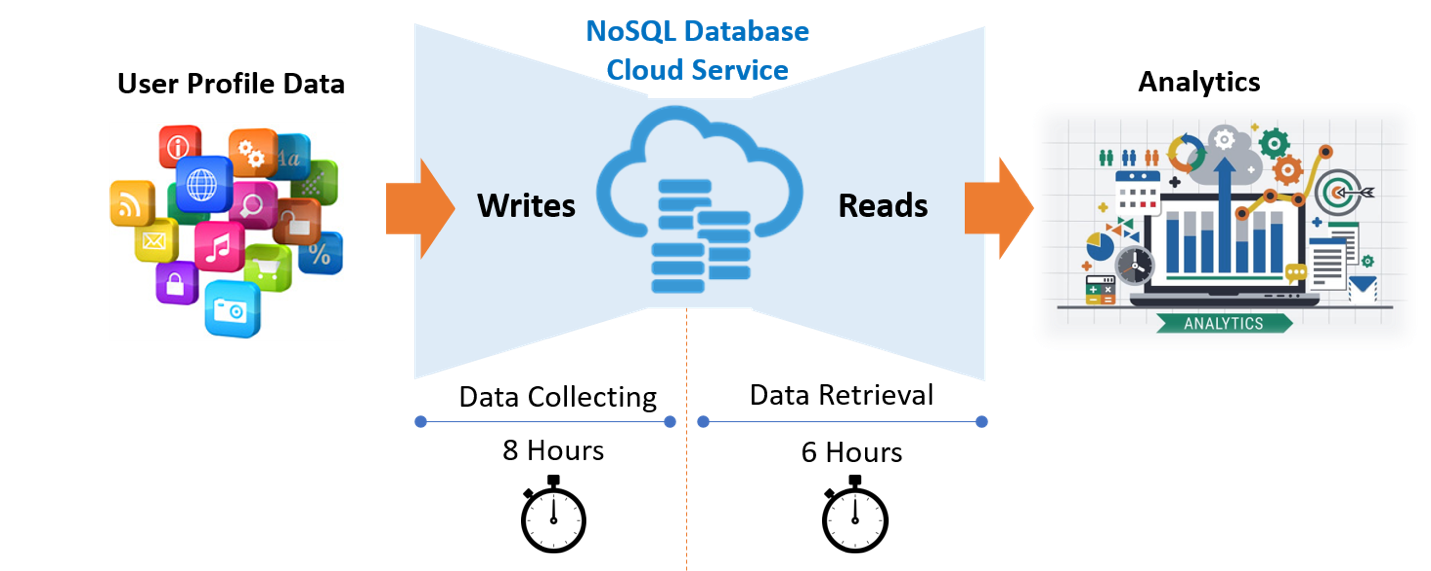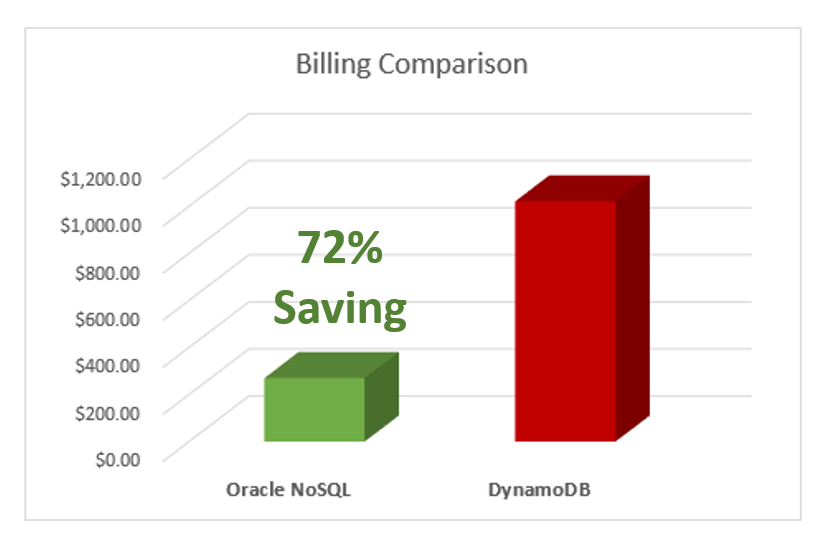Blog Authored by: Michael Brey, Dave Rubin and Tim Goh; Oracle NoSQL Database Cloud
Introduction
Developers looking for fast and predictable response time at scale for their document, columnar and key-value database centric applications prefer Oracle’s NoSQL Database Cloud Service. This fully managed service offers ACID transactions, serverless scaling, comprehensive security, and throughput-based pay-per-use pricing at a low cost. You can try it for free today with Oracle Cloud account that includes US$300 in free credits for a 30-day trial.
Oracle’s NoSQL Database Cloud Service (NDCS) offers superior features and helps customers lower their AWS DynamoDB cost by up to 72%. Let’s run through some step-by-step calculations comparing both services.
Oracle NDCS supports many use cases such as fraud detection, IOT, mobile apps, social media, online gaming, data caching and many more. In this blog, we will focus on the customer 360 use case.
Use Case and Billing Example
Let’s say Company XYZ deploys a Customer 360 solution using Oracle NoSQL Database Cloud Service (NDCS) for data storage. It collects about 100 GB of user profiling data daily from their website and runs analytics on that data between midnight and 6:00 am the next morning. Data is written continuously to NDCS during the day from 9 am to 5 pm while the data is read from the service by analytics software from 12 midnight to 6 am.

The following calculations compare Oracle NoSQL Database Cloud Service vs. AWS DynamoDB billing. The criteria used for this calculation can be found below.
Total Monthly Billing
| NoSQL Database Cloud Service |
DynamoDB |
|
| Total Monthly Read/Write Billing |
$217 |
$821.19 |
| Total Monthly Storage Billing |
$52.80 |
$200 |
| Monthly Billing |
$269.80 |
$1021.19 |
Table 1
Huge Upside Using Oracle NoSQL Database Cloud Service for Your Analytics
As the Table 1 above shows, customers can enjoy up to 72% cost savings using Oracle NoSQL Database Cloud Service when compared to AWS DynamoDB. The cost savings increase if the applications are write intensive versus read intensive.

Calculation Details
Throughput Calculation
Total Daily = ( #Read/Write Unit Provisioned/ Second ) * ( # of hour ) * ( Read/Write Unit Hourly Pricing (See Table 5))
Total Monthly = Total Daily * 31 days
| #Unit(KB) per Second Provisioned |
Total Daily Workload Hours |
NoSQL Database Cloud Service Total Daily Billing |
DynamoDB Total Daily Billing |
|
| Read Unit |
5,000 |
6 |
$0.2580 |
$0.4875 |
| Write Unit |
5,000 |
8 |
$6.7419 |
$26 |
| Total Daily |
$7.00 |
$26.49 |
||
| Total Monthly (31 days) |
$217 |
$821.19 |
Table 2
Storage Calculation
Total Monthly = ( #Storage GB Provisioned/Month ) * ( Storage GB Monthly Pricing (See Table 4))
| #GB per month |
NoSQL Database Cloud Service Monthly Billing |
DynamoDB Monthly Billing |
|
| Storage DB |
800 |
$52.80 |
$200 |
Table 3
Calculation Criteria
- Here are some assumptions and criteria for the apples-to-apples comparison.
- Pricing
- Oracle NoSQL Database Cloud Service offers a simple and predictable pricing model. The below table shows the comparison to AWS DynamoDB using provisioned pricing (Non-reserve).
- At the time of this writing, the pricing for Oracle NoSQL Database Cloud Service (Ashburn) vs. DynamoDB (North Virginia) are as follows:
Published pricing at service websites
|
|
NoSQL Database |
DynamoDB |
| 1 Read Unit |
0.0064 |
0.00013 |
| 1 Write Unit |
0.1254 |
0.00065 |
| 1 Storage GB |
0.066 |
0.25 |
Table 4
- Normalized hourly pricing
- Since the pricing for NDCS and DynamoDB is expressed slightly different, normalizing to hourly pricing for throughput is important.
- Hourly pricing for read and write units is prorated based on the monthly pricing using 744 hours per month for NDCS to match DynamoDB.
- DynamoDB Read Unit (4KB, strong consistency) hourly pricing is normalized to 1KB and eventual consistency to match NDCS. The formula used is (1 DynamoDB Read Unit Pricing) / 4 / 2.
| NoSQL Database |
DynamoDB |
|
| 1 Read Unit |
0.0000086 |
0.00001625 |
| 1 Write Unit |
0.0001685484 |
0.00065 |
Table 5
- Other considerations and assumptions used for the comparison:
- Both services use the hourly pricing for read unit and write unit.
- Free tier from both services is not included in calculation since each service has its own free offer to users.
- A single table (or “collection”) is used.
- Only the primary key is used for reads and writes. No secondary indexes are considered.
- Non-transaction reads and writes are considered. 1 write unit and 1 read unit (1KB, eventual) are used.
- 8 hours (9am – 5pm) for writing data to both services and 6 hours (12am – 6am) for reading data for analytics from both services.
- Eventually consistent reads are used for analytics.
- Record size is approximately 1KB.
- Time To Live (TTL) is set at 7 days.
- A constant amount of 800GB is used during a month with TTL setting. Since DynamoDB is dynamically provisioned, this will simplify the calculation.
- The number of records processed by writes and reads are the same with the assumption that only new records are used for analytics.
Start saving today
